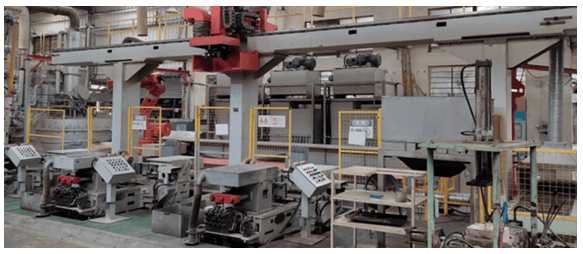Gravity casting uses the Earth’s gravity to fill the mold with molten metal. It is one of the most classic and common processes for producing non-ferrous metal castings like aluminum and copper. It uses low-cost equipment to achieve high-quality output. It is especially suitable for small to medium batch production. Gravity casting offers stability and cost-effectiveness. It is one of QD’s most fundamental and mature casting services.
What is Gravity Die Casting? What are its features?
Gravity die casting is a metal forming process. It uses gravity to pour molten non-ferrous metal into a metal mold. The metal cools naturally to form the casting. It is one of the core processes for non-ferrous metal casting.

Its main features include:
Simple Process: It uses simple equipment and needs no external pressure. It relies on gravity to fill the mold.
Durable Molds: Metal molds can be reused thousands of times. They have a long service life.
Wide Material Compatibility: It is especially suitable for non-ferrous metals and their alloys like aluminum, copper, and magnesium.
Stable Quality: The castings have a dense structure. They offer good mechanical properties and a smooth surface finish.
Cost-Effective: It requires low equipment investment. Production costs are controllable. It suits small to medium batch orders.
QD has deep experience in gravity die casting technology. We provide high-consistency, low-defect casting solutions for you.
How Does It Work?
The gravity casting process mainly includes these steps:
Mold Preparation: Preheat the metal mold. Spray a release agent to prevent sticking.
Metal Melting: Heat non-ferrous metals like aluminum or copper to liquid state in a furnace. Strictly control temperature and composition.
Pouring: Use a ladle or automatic pouring machine to pour molten metal into the mold through the sprue. Gravity naturally fills the cavity.
Cooling & Solidification: Let the metal cool naturally in the mold to form a solid casting. Adjust cooling time based on casting thickness and material.
Demolding & Cleaning: Open the mold and remove the casting. Perform post-processing like removing gates and trimming flash.
Quality Inspection: Ensure casting quality through dimensional checks and non-destructive testing (e.g., X-ray).

The entire process emphasizes smooth filling to prevent turbulence and air entrapment. QD uses automated pouring and real-time monitoring systems. This helps reduce defects like porosity and shrinkage.
Core Advantages of Gravity Die Casting
Gravity die casting performs exceptionally well in cost, quality, and efficiency. It is particularly suitable for small to medium batch production.
| Advantage | Description | Value to You |
| Simple equipment, low cost | Molds can be reused thousands of times. Equipment investment and maintenance costs are much lower than processes like die casting. | Reduces initial investment. Suitable for limited budgets or small/medium batch orders. |
| Good casting quality | Smooth filling. Stable molten metal flow. Dense casting structure. Excellent mechanical properties. | Improves product reliability. Reduces post-processing and rejection rates. |
| High production efficiency | Short cycle times. Suitable for small/medium batch production. Flexible mold changes. | Quick response to market demand. Shortens delivery time. |
| High material utilization | Simple gating and riser system. Less metal waste. High recycling rate. | Saves material costs. Meets environmental requirements. |
| Excellent surface quality | Smooth casting surface. High dimensional accuracy. Small subsequent machining allowance. | Reduces finishing steps. Lowers overall costs. |
| Great process flexibility | Easy to adjust molds and process parameters. Adapts to different shapes and sizes of castings. | Supports customized production. Meets diverse needs. |
The QD factory further enhances these advantages:
Mold Design: We use CAD/CAE simulation analysis. We optimize the gating system and cooling channels. This extends mold life.
Quality Control: We strictly implement the ISO 9001 system. We test the mechanical properties and inspect the microstructure of every batch of castings.
Cost Control: Through bulk purchasing and lean production, we achieve competitive pricing for you.
Its Application Scenarios
Due to its excellent performance and cost-effectiveness, gravity casting is widely used in the following fields:
Automotive Industry
Aluminum wheels, engine pistons, cylinder heads, transmission housings. These parts require high strength and heat resistance. Gravity casting meets these needs perfectly.
Mechanical Engineering
Copper sleeves, bearing housings, valve bodies, pump casings. Gravity castings are dense and wear-resistant, suitable for high-load environments.
Electronics & Electrical
Heat sinks, connector housings. It utilizes the good thermal conductivity and surface quality.
General Hardware
Kitchenware, lamp parts. It balances aesthetics and durability.

| Industry | Typical Parts | Material | Advantages |
| Automotive | Aluminum wheels, pistons | Aluminum alloy | High strength, lightweight, fatigue resistant |
| Machinery | Copper sleeves, valves | Copper alloy | Wear-resistant, corrosion-resistant, good thermal conductivity |
| Energy | Gas turbine components | High-temperature alloy | Dense structure, stable high-temperature performance |
| Home Appliances | Compressor housings | Aluminum alloy | Smooth surface, good air tightness |
QD has supplied gravity castings to numerous automotive and machinery clients. Our aluminum wheel and cylinder head projects achieved zero-defect delivery, gaining market trust.
Gravity Casting vs. Other Casting Methods
To better understand the position of gravity casting, here is a brief comparison with common casting methods:
vs. Die Casting:
- Die casting uses high pressure to fill the mold. It has high efficiency and suits mass production. But the equipment is expensive, and castings can have gas pores.
- Gravity casting has lower costs. The castings have better mechanical properties. It is more suitable for small/medium batches.
vs. Sand Casting:
- Sand casting has low mold costs. It is suitable for large parts and single-piece production. But the surface is rough, and precision is low.
- Gravity casting offers high surface quality and stable dimensions. It is suitable for small/medium parts.
vs. Low Pressure Casting:
- Low pressure casting fills the mold smoothly and has good quality. But the equipment is complex.
- Gravity casting is more economical and offers higher flexibility.
Gravity casting achieves the best balance between quality, cost, and efficiency. This is why QD recommends it as the preferred process for non-ferrous metals.
Future Development Trends of Gravity Casting
Currently, gravity casting is evolving towards higher efficiency and better environmental friendliness:
- Lightweight Materials: Increased use of high-strength aluminum and magnesium alloys. Gravity casting adapts well to these materials.
- Intelligent Control: IoT and sensors monitor pouring temperature and cooling rates in real-time. This improves consistency.
- Green Manufacturing: Optimized energy use and material recycling reduce carbon emissions.
We actively follow these trends. We invest in R&D for automation and green processes. This ensures you receive cutting-edge casting solutions.

Do you need high-quality, medium-volume aluminum or copper alloy castings? Gravity casting is our fundamental and mature service. QD has complete production lines and a strict quality system. We ensure every casting meets your expectations. Contact us now for a quote.
FAQ
1. What materials are suitable for gravity casting?
It works best with non-ferrous metals like aluminum, copper, magnesium and their alloys. It is not suitable for high-melting-point materials like steel.
2. What is the size range for gravity castings?
It is typically used for small to medium-sized castings. The weight ranges from a few grams to several tens of kilograms. The maximum projected area generally does not exceed 1 square meter.
3. What is the production lead time?
For small/medium batches, it usually takes 2-4 weeks. The exact time depends on mold preparation and part complexity. We offer expedited services.
4. How is the cost calculated?
Cost includes mold cost, material cost, and processing cost. Molds can be reused. Larger batches lead to lower cost per piece.
5. What quality grade can gravity castings achieve?
Surface roughness can reach Ra 3.2-6.3 μm. Dimensional tolerance is typically controlled at CT6-CT8 grade. Mechanical properties meet national standards.
6. How do you ensure defect-free castings?
We optimize mold designs, control process parameters, and perform comprehensive inspections (like X-ray and penetrant testing). QD provides quality reports and after-sales support.
